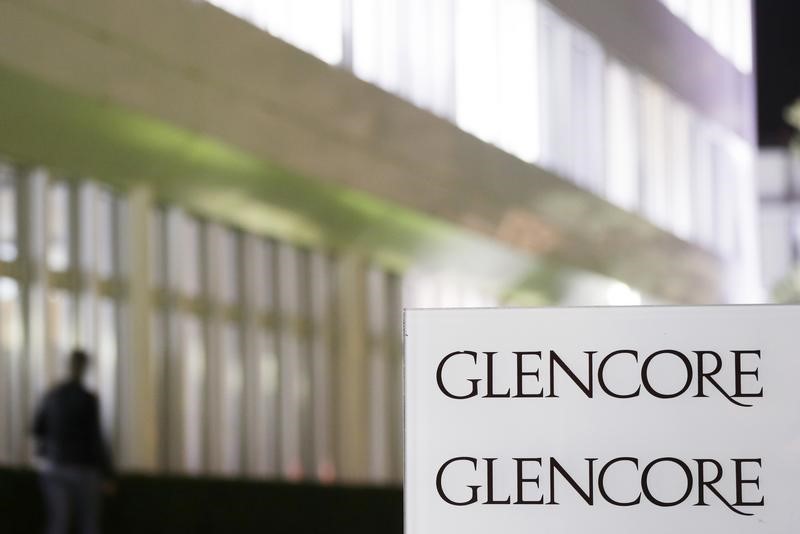BofA warns Fed risks policy mistake with early rate cuts
Investing.com -- Glencore (LON:GLEN) shares slipped more than 5% on Wednesday after reporting 2024 EBITDA of $14.36 billion, slightly below the $14.55 billion consensus estimate.
Earnings declined 16% year-over-year, despite the inclusion of EVR from mid-2024, as lower coal prices weighed on performance.
Marketing EBIT of $3.2 billion, down 8% year-over-year, performed slightly better than expected.
In an effort to support shareholder returns, Glencore announced a $2.2 billion capital return program, consisting of a $1.2 billion base dividend and a $1 billion share buyback to be completed by August.
“We believe that buy-side capital returns expectations were approximately at US$3bn,” said analysts at Morgan Stanley (NYSE:MS) in a note.
Glencore’s 2025 guidance reflected weaker volumes, in-line capex, and lower cash costs. Based on mid-point volume guidance, cash costs, and spot prices, the company projects 2025 EBITDA of $15.5 billion, below consensus estimates of $16.85 billion.
“The bottom line is that we don’t expect clear, strong commodity tailwinds for Glencore until next year,” said analysts at Jefferies in a note.
Copper production guidance for 2025-27 is 5-8% lower than VA consensus, largely due to mine plan changes in South America, while zinc guidance is 2-14% lower.
Met-coal production guidance is up to 7% higher. Industrial capex remains at $6.6 billion annually, slightly above VA consensus of $6 billion, though the latter may not fully account for EVR.
On costs, copper unit costs were slightly higher than expected due to lower volumes and weaker cobalt/custom metallurgical credits, primarily from South America.
Meanwhile, coal and zinc costs were lower, benefiting from portfolio optimization and cost-saving initiatives.
Glencore’s net debt stood at $11.2 billion, exceeding the company consensus of $8.7 billion, due to the assumption of $0.6 billion in EVR net debt and higher leases.
Net funding came in at $36.4 billion, above the consensus of $33.7 billion. Free cash flow to equity (FCFE) was $4.5 billion contributing to the variance in net funding.
The company also recorded $5.3 billion in exceptional items for FY24, including $3.6 billion in the second half, primarily from $1.5 billion in smelter impairments and a $0.9 billion site rehabilitation provision for non-operational assets.
In 2025, copper production is projected to decline from 952,000 tons to 850,000-910,000 tons before rebounding to 930,000 tons in 2026-2027 and reaching 1 million tons in 2028. By 2026, copper-equivalent production is expected to reach 3.8 million tons, driven by EVR operations lasting a full year.
Glencore shares slipped 3% on Wednesday after reporting 2024 EBITDA of $14.36 billion, slightly below the $14.55 billion consensus estimate.
Earnings declined 16% year-over-year, despite the inclusion of EVR from mid-2024, as lower coal prices weighed on performance.
Marketing EBIT of $3.2 billion, down 8% year-over-year, performed slightly better than expected.
In an effort to support shareholder returns, Glencore announced a $2.2 billion capital return program, consisting of a $1.2 billion base dividend and a $1 billion share buyback to be completed by August.
“We believe that buy-side capital returns expectations were approximately at US$3bn,” said analysts at Morgan Stanley in a note.
Glencore’s 2025 guidance reflected weaker volumes, in-line capex, and lower cash costs. Based on mid-point volume guidance, cash costs, and spot prices, the company projects 2025 EBITDA of $15.5 billion, below consensus estimates of $16.85 billion.
“The bottom line is that we don’t expect clear, strong commodity tailwinds for Glencore until next year,” said analysts at Jefferies in a note.
Copper production guidance for 2025-27 is 5-8% lower than VA consensus, largely due to mine plan changes in South America, while zinc guidance is 2-14% lower.
Met-coal production guidance is up to 7% higher. Industrial capex remains at $6.6 billion annually, slightly above VA consensus of $6 billion, though the latter may not fully account for EVR.
On costs, copper unit costs were slightly higher than expected due to lower volumes and weaker cobalt/custom metallurgical credits, primarily from South America.
Meanwhile, coal and zinc costs were lower, benefiting from portfolio optimization and cost-saving initiatives.
Glencore’s net debt stood at $11.2 billion, exceeding the company consensus of $8.7 billion, due to the assumption of $0.6 billion in EVR net debt and higher leases.
Net funding came in at $36.4 billion, above the consensus of $33.7 billion. Free cash flow to equity (FCFE) was $4.5 billion contributing to the variance in net funding.
The company also recorded $5.3 billion in exceptional items for FY24, including $3.6 billion in the second half, primarily from $1.5 billion in smelter impairments and a $0.9 billion site rehabilitation provision for non-operational assets.
In 2025, copper production is projected to decline from 952,000 tons to 850,000-910,000 tons before rebounding to 930,000 tons in 2026-2027 and reaching 1 million tons in 2028. By 2026, copper-equivalent production is expected to reach 3.8 million tons, driven by EVR operations lasting a full year.
